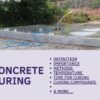The efficiency of the construction industry is at stack because of construction waste generation and due to its direct impact on the environment. The future and sustainability of this gigantic industry lie heavily on material handling and waste management at construction site. Because such wastage and general are depleting environmental resources speedily.
Today, a key area of concern within the construction industry is waste management. The construction industry across the globe is generating heaps of dump waste and is the reason why companies are looking for strategies to reduce construction and demolition waste by reuse and recycle.
This would significantly reduce the amounts of landfill payments.
Key Issues in Materials and Waste Management
The construction waste was previously considered as inert. But with the growing use of organic polymers and chemical additives, it is now contaminated by hazardous substances. This is the reason why about 40% of the construction and demolition waste is disposed to landfill.
With this, the available landfill space is considerably decreasing and with people opposing for creation of new landfill sites, has led to escalating the landfill fees. It represents a significant cost that has been added up into the construction contracts and ultimately, has been put on society as a whole.
The local authorities and environmental regulators are more active in promoting the very idea of sustainable construction. Reducing the construction waste not only helps in reducing the amount of required landfill space but would also help to get better site productivity.
How to implement waste management plan at site?
If we consider an example of a non-residential (institutional) building that has multiple floors over a considerable area. Such a project involves conventional building and construction activities that are easy to replicate in mega projects. It is critical to develop material management strategies and opportunities regarding material waste management. You can collect the data by visiting the site and observing the day to day handling of material and strategy to cope with material wastage.
Prepare a detailed waste management plan to follow and for minimizing the waste generation overall across the site. Carry out an on-site waste sorting by setting up separate marked waste buckets.
You can separate the waste including concrete and aggregate, soil and sand, wood materials, brick and blocks, roofing, plastic, and packaging materials. You can ensure minimization by reusing and recycling of construction waste materials on site.
In general you can expect to recycle and reuse 45% of the waste materials and that is a big saving. The net reusing and recycling on-site can be somewhat 2.5% of the total budget of the project. This is a significant profit in the Contractor’s pocket.
You can use awareness campaigns to guide craftsman and labor from the subcontractor so that they handle material correctly and minimize waste.
Material Management Process and construction wastage
A significant amount of the purchased construction material leaves the site as waste. Sustainable construction development is only deemed possible when the construction activities are managed in a way to prevent and reduce the waste generation. Managing material and minimizing wastage is extremely vital besides managing resources and labor.
Material management is an integral part of construction management which ensures the timely availability of the material in the right quantity and quality. As materials represent 30-70% of the construction costs (Donyavi and Flanagan 2009), its management must be considered throughout the construction and production periods.
Ineffective material management can cause an inevitable loss for a construction project. There would be significant disruption to the progress of the site and construction program would be delayed. On the other hand, because of a workable material management strategy, it would be much easier for the management to meet construction program and budget milestones.
Through augment efforts of construction management and integrated logistics the material wastage can be reduced considerably. The construction companies are now using technology systems for better management of materials. The site management is made responsible for effective management of materials during delivery, set down, storage and usage on site.
Material Scheduling
The prime aspect of material management process in construction is material scheduling. A considerable amount of material waste can be avoided by ordering the correct quantities and lengths. This is only possible by correctly estimating the required quantity.
However, with mistakes like the misinterpretation of drawings, faulty workmanship, careless handling, poor storage, and theft or vandalism, the correct estimates can go wrong.
To be realistic, it is obvious that eliminating wastage in construction projects is practically not possible like pick-up waste and waste of broken bricks and tile. However, one can cut short the material wastage by avoiding mistakes as mentioned prior.
Impact of material handling on overall site management
Besides the credit to avoid materials from going to landfills, material waste management helps in overall site management. A well-organized site where the materials have been effectively managed provides a safe, tidy and efficient working environment.
Material Order & Delivery
After material scheduling, the next important consideration in material management is ordering materials. The materials should be ordered at the right time and in the right quantity and quality. Aside from items required from foreign suppliers or special order; the material must not be purchased earlier. Early ordering would require storage of materials on-site for longer periods and there are more chances of material getting deteriorated or stolen. If there is less space available at the site, then there would be increased disruption to progress.
With an efficient material purchasing systems you can significantly reduce the labor costs, reduced delay for materials availability, increase productivity, and reduced warehouse costs.
While dealing with materials that are required in large quantities – like bricks, the delivery can be phased to suit the construction program and space available for storage at the site. It is a part of the planning process to ensure that all the required materials are delivered at the site incorrect time, in sufficient quantity, and of the right quality. In urban site, there may be space constraints and it may be required to have both crane lift and delivery truck at the street. At the time, materials need to be stored off-site but this consideration requires the client’s approval.
Offloading & Storing
For an effective and safe operation during material handling, it is required that the position of delivery and set down areas doesn’t obstruct the project progress. The construction manager has to prepare a material delivery schedule which is in line with the construction program. A convenient location of set down area is crucial for effective material management. The set down areas should be easily accessible by delivery vehicles to ensure flawless equipment handling and site operation.
The off-load strategy depends on the material characteristics and delivery method. But above all, the materials must be separated to avoid sorting later in the project. The storage of materials must be in a way that there is the minimum required handling time.
Storing, Protecting & Issuing
The site layout plan should include material delivery areas, material storage areas, material handling including material movement on the site showing horizontal and vertical movements and the moving equipment required. It would help in minimizing site labor time concerning the movement, travel, and transportation of materials.
In the long run, the operatives will be able to spend more time on construction tasks and therefore achieve greater productivity. The deliveries must be directed on-site by appropriate signage. To avoid any breaking or other material wastage the storing must be carried out correctly i.e. stacking on top of each other in a limit. For this, the size, shape, weight, and mode of delivery must be considered for safe handling and stacking.
Some materials will be stored on-site and will be used over an extended time while others may be used directly from the delivery truck. Anyhow, the material issuing need to well-documented to ensure correct quantity being supplied to the labor to avoid minimum damage, theft, and wastage.
Where possible, the materials must be delivered close to their final storage locations to reduce the amount of handling. It is pointless to state efficiency of material handling and management has a direct benefit to the productivity of construction projects.
Construction Waste Management
The purpose of construction waste management should be to avoid it in the first place instead of managing it which is expensive and difficult. The waste that arises from the construction process at site level must be reduced, recycled and reused for a sustainable industry.
Following are some of the definite steps of waste reduction strategy that can minimize waste and improve profit margins.
- Separation of Materials: To maximize the recovery of construction and demolition waste, waste sorting and diversion must be carried out. For subsequent recycling and reuse, the waste should be destined in separate bins or disposal areas according to their material group, treatment, and level of contamination.
- Litter Management: Construction and demolition sites are a major source of litter. Besides the fact that it portrays a bad picture of poor management of construction sites, it is unlawful. Along with construction material waste, worker trash or items is falling from delivery or hauling vehicles. Clean and orderly sites are much safer and easier to work in as compared with trashy, disorderly work sites.
- Effective Delivery and Storage: An effective strategy to tackle this conundrum of construction waste is by following waste-efficient material procurement. Although one can easily blame most of the construction waste is generated while executing work activities. But now it’s a fact that activities and actions during design, procurement, delivery, and storage also the reason for elevated waste generation. The suppliers should be committed to following waste preventive measures like less packaging and modification of materials to conform to project requirements.
- Packaging: The suppliers must be avoiding unnecessary packaging. Packaging waste significantly contributes to the waste stream. Employ subcontractor for collection of packaging waste like cardboard, plastic, and metal.
- Safe disposal of unavoidable waste: The unavoidable building material waste that can’t be reused or recycled must be safely recovered and disposed of in the license landfills. Keep all the landfill receipts for waste minimization site review and data collection requirements of the project.
- Waste Management Plans: Waste management plan provides a system to manage waste generated from materials for recovery or disposal and provide an opportunity for cost savings. The waste management plan must set forth the responsibility of managing material waste. It must record and identify the quantity and type of waste. The waste must be measured and monitor for reviewing its effectiveness.
Waste management is a crucial aspect of construction management and only hope for a sustainable future. Concrete steps are required to reduce, recycle and reuse construction waste at project sites. This would not lead this industry to significant social, economic, and environmental benefits.
There is a need to undertake early design decisions while considering waste management strategies. These 3-R waste minimization concepts must be kept in mind while finalizing the type and quantity of materials.
References:
http://eprints.utar.edu.my/2497/2/PJC-2017-1605462-1.pdf
https://www.tandfonline.com/doi/abs/10.1080/014461998372600
https://pdfs.semanticscholar.org/783f/ed86c5d6243b1eb89a92ceb14841bc3c94a2.pdf
https://www.sciencedirect.com/science/article/pii/S0956053X1830045X
















